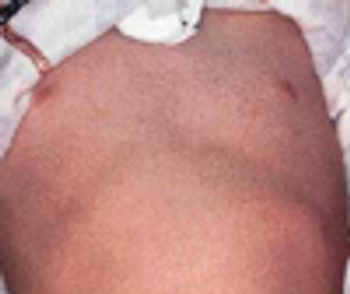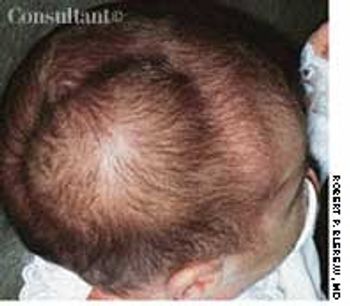
Rarely encountered these days, scarlet fever is believed to be caused by sensitization to an erythrogenic toxin produced by strains of group A beta-hemolytic streptococci.

Rarely encountered these days, scarlet fever is believed to be caused by sensitization to an erythrogenic toxin produced by strains of group A beta-hemolytic streptococci.

A sleeping 12-month-old child was spotted alone in a parked car by a passerby. The passerby observed the situation for a period of time, only to see no one returned for the child. The passerby then called 911 for help after an undetermined length of time.

A right parietal cephalhematoma was first noted on this 2-week-old girl 2 days after her birth.

The overwhelming majority of you voted “yes” when asked whether you saw a role for state intervention and possible placement in protective custody of children with life-threatening obesity. We’d like to hear your thoughts about this issue …. For example, how long would you counsel the patient’s parents before you called child protective services? What’s your BMI cutoff? What are your concerns about the home into which an obese child might be placed, and the potential psychological fallout of being removed from home? And when is it “safe” for the child to return home? For those of you who answered no, please tell us how you help children with life-threatening obesity short of considering removing them from their home? Please send us your comments-just click here and type into the comments box. Thank you. -The Editors

Designed to create an excellent care environment among patients, parents, and care providers, AAP says that the medical home should be ?accessible, continuous, comprehensive, family centered, coordinated, compassionate, and culturally effective.? A new study provides a perspective on accessibility to the medical home for children who may need comprehensive primary care the most?those with public health insurance.

The age of children does seem to affect how well amblyopia responds to interventions, but a new study suggests that treating older children remains worthwhile, even if their response is less pronounced than in younger children. Find out how long to continue treatment, even for children older than 7 years.

Although drug regimens such as the protease inhibitor lopinavir-ritonavir may have lowered the HIV transmission rates in newborns to less than 1%, a study finds that postnatal treatment with the combination was more likely to cause adrenal dysfunction in newborns when compared with a zidovudine-based treatment. Read about the nuances of the study and the researchers? recommendations.

The myth of the hypoallergenic dog is so pervasive that even President Obama?s family adopted a Portuguese water dog because of his daughter?s allergies. But a new study says that neither the First Dog, Bo, nor any other breeds actually are hypoallergenic. Here?s information to help you counsel parents on the pros and cons of getting a family dog and when.

Glycated hemoglobin (HbA1c) may now be internationally accepted for diagnosing diabetes, but it appears to be far less accurate for adolescents than adults, according to a new study. Read the results and analysis of a recent study here.

Concussions don?t cause confusion just for young athletes. Recent research on the subject confounds pediatricians, too, making it less clear how to follow guidelines and new legislation calling for physician evaluation and medical clearance before returning to play. Our experts review the concerns and considerations.

The number of children in the United States was 74.2 million in 2010 and is expected to reach 88 million by 2030, according to a recent government report. The market is not only growing, but changing, which may present new challenges for pediatricians in understanding cultural differences and even the language spoken by parents. See the stats on what to expect.

New, groundbreaking studies are finding links between development of autism spectrum disorder and environmental influences in the womb, during the birth process, and possibly after. Here's a list of potential and neonatal factors that may be associated with autism risk.

Imagine if you had a quick and easy way to prove to a parent that their child?s illness was viral not bacterial, and that an antibiotic was not necessary. That day may be coming sooner than you think. Israel researchers have developed such a test that is time-saving, easy to perform and may soon be commercially available.

Photoclinic section editor CFP

Preschool-aged children who watched violent daytime television programming or any television before bedtime often couldn?t sleep at night, and their sleep problems increased with each additional hour of nighttime media viewing.

Aripiprazole, olanzapine, and risperidone appear to increase body fat and change insulin sensitivity in children being treated for disruptive behavior disorders, according to new research presented at the meeting of the American Diabetes Association meeting in San Diego.

Young people with type 1 diabetes have thicker and stiffer carotid arteries that indicate atherosclerosis, a risk factor for heart attack and stroke in adults, data from a recent study indicate.


Uncontrolled Asthma : When to step up therapy Dog bites and PTSD : Helping wounded children cope Point-of-care testing : What's right for your practice? Dermcase : A baby with giant freckles? Puzzler : Infant has respiratory distress and weak cry

Using a nontoxic, glowing, hand-washing gel appears to be an effective way to improve children?s hand-washing ability.

Treatment with fluticasone furoate nasal spray reduces interleukin (IL)-6, a proinflammatory cytokine, in the adenoid tissues of children with obstructive sleep apnea syndrome, according to a study in the Archives of Otolaryngology?Head and Neck Surgery.

Findings of a large retrospective cohort study support the use of laparoscopic appendectomy (LA) in children.

Early findings from a long-running US study of preterm infants suggest that babies born prematurely face a greater risk of heart and health problems as adults.

For an adult to appreciate the experience of a child bitten by a dog, especially if it is at the shoulders or higher, imagine being attacked by an angry, opened-mouthed, growling bear near your face. Your immediate shock and emotional overload would be similar to that of a dog-bitten child. There is, however, one striking, important difference.

Self-induced vomiting is a frequent practice among adolescents trying to lose weight, according to a new study.

Many years ago, it was customary for pediatricians to maintain a small office clinical lab that included a hematocrit spinner as well as an incubator used for throat and urine cultures.

Incorporating a concise asthma decision-making tool into medical records consistently improved documentation of key asthma indicators during pediatric primary care visits, a new study shows.

Toddlers identified as "late talkers" have no increase in psychosocial problems compared with other children during childhood or adolescence, as long as they don't have comorbid behavior problems, according to Australian investigators.

Research is indicating that fetal alcohol spectrum disorders may be far more prevalent than previously realized, according to a spokesperson on behalf of NIAAA.

A new clinical report from the American Academy of Pediatrics, American Academy of Family Physicians, and American College of Physicians outlines the steps that must be taken to facilitate transition from pediatric to adult medical care for patients with and without special health needs.